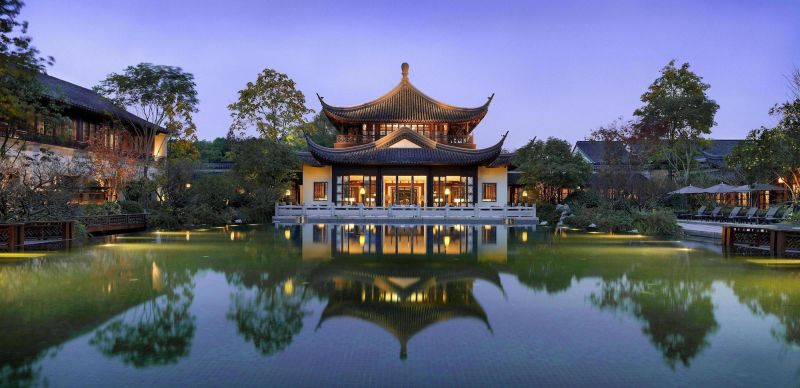Escape Shanghai in the Yangtze River Delta
Home to a cool 88 million people, the Yangtze River Delta is the most populated region on Earth. In the center of it all is Shanghai, China’s commercial capital and a must-visit destination.
Shopping, ancient gardens, temples, and dynamic architecture make it one of the most fascinating megacities. However, that’s not the only reason to go. Shanghai is also an easy jump-off point for more rustic side trips.
From the canals of Shaoxing to Hangzhou’s famous West Lake, China’s ancient “water towns” and lush tea plantations are just a 20- to 30-minute bullet train ride away. Here are five day trips you’ll enjoy when you travel here:
1. Hangzhou

A 45-minute bullet train ride from Shanghai (on a “D” or “G” train), Hangzhou has been praised by poets and explorers alike (including Marco Polo) as one of the most photogenic places in China.
The city revolves around West Lake, which is best explored by bike in the morning when the byways are empty and willow tree-lined causeways are shrouded in ethereal mist. Around the lake, travelers will find dozens of ancient pagodas, gardens, carp ponds, half-moon bridges, and temples—not to mention easy treks through the hillsides.
The majority of hotels—including a Four Seasons Hotel Hangzhou at West Lake and the historic Shangri-La Hotel, Hangzhou—are along the western shores. Moreover, a cluster of gardens and islands were once part of Emperor Qianlong’s holiday palace back in the 19th century.
However, the countryside is equally inviting. Outside of town, travelers can explore the Dragon Well Tea Village for fresh air and Longjing green tea.
2. Shaoxing

A 20-minute bullet train ride southeast of Hangzhou will drop travelers in Shaoxing, which—perhaps optimistically—has been dubbed the “Venice of Asia.” A small city (by China’s terms) of 5 million, Shaoxing is best known for its romantic canals and stone bridges.
Consequently, more than 4,000 bridges connect the cityscape, and a stroll along the cobbled pathways will take you past traditional white houses with slate-tiled roofs. Shaoxing is also famous for its literary history, once home to Chinese scholar Zhou Enlai and famous writer Lu Xun.
Most of the action revolves around the eponymous Lu Xun Road pedestrian strip, where travelers can walk through Lu Xun’s 19th-century residence.
The most charming hotel in Shaoxing is the Xianheng Hotel, which dates back to 1894—supposedly opened by the writer’s uncle. Here you’ll find beautiful lotus ponds, antique furniture, and a restaurant serving traditional Shaoxing cuisine, featuring stinky tofu, braised pork belly, and Shaoxing wine.
3. Moganshan

La Passage Mohkan Shan is located about a 30-minute drive northwest of Hangzhou, or 2.5 hours southwest of Shanghai. The small village of Moganshan serves as a refuge for nature lovers, where the beauty lies in the simplicity of exploring its bamboo forests and tea plantations.
Moreover, a typical day might include an easy bike ride through the hills, a tea tasting, lounging by the pool, or a zip-line outing at Discovery Adventure Park. While it might appear untouched, Moganshan was actually a popular hill station during the 19th and 20th centuries.
This is where Shanghai’s foreign expats and politicians (including Chairman Mao) sought refuge for cool mountain air during the city’s steamy summers. As a result, elite jetsetters are drawn to eco-friendly retreats like Naked Stables and Le Passage Mohkan Shan.
Offering an ultra-posh experience, there’s also La Residence—a villa with 30-feet-tall ceilings and eclectic Scandinavian furniture that’s nestled in the tea hills.
4. Ningbo

An easy drive from Shanghai across the Hangzhou Bay Bridge—the world’s longest trans-oceanic bridge—Ningbo is a rapidly modernizing city with a long history. Ningbo hosts one of the busiest shipping ports in the world while being one of China’s oldest cities.
Dating back to 4800 BCE, Ningbo was an important stop on the Silk Road, featuring beautifully preserved pagodas and towers including the Tang Dynasty-era Tianfeng Tower.
One of the city’s most scenic areas is the centrally located Moon Lake, where travelers can find the Tianyi Pavilion, an ancient library, temple, and stunning Chinese pavilions. History prevails throughout the city, from China’s oldest wooden structure—the Baoguo Temple in the north—to the Tang Dynasty-era Qita Zen Buddhist Temple downtown.
The city has also drawn attention for its exciting architecture, such as the Ningbo History Museum. Designed by Pritzker Prize-winner Wang Shu of Amateur Architecture Studio, the contemporary museum is a blend of concrete and bamboo, showcasing traditional tiling techniques and handmade bricks that pay homage to demolished houses in China.
5. Suzhou

About a 20-minute train ride west of Shanghai, Suzhou is yet another beautiful canal city—split north to south by the Beijing-Hangzhou Grand Canal.
Nearly half of this 2,500-year-old town is covered in water, with rivers and canals dividing the streets into a checkerboard pattern. The romance continues in the cobbled streets and more than 60 Chinese gardens scattered about the city. The main sights include the 12.85-acre Humble Administrator’s Garden, a World Cultural Heritage site dating back to 1509.
A walk or bike ride here reveals lotus pools, poetic temples, bamboo groves, and elegant courtyards. Come evening, Pingjiang Lu serves as the best pedestrian street for a leisurely stroll past historic white houses and trendy teahouses. The Suzhou Silk Museum also showcases the city’s 4,000-year-old silk-weaving traditions.
Should time allow, there are few other “water towns” nearby that are worth a visit, including Zhouzhuang, Xinchang, and Nanxiang.





